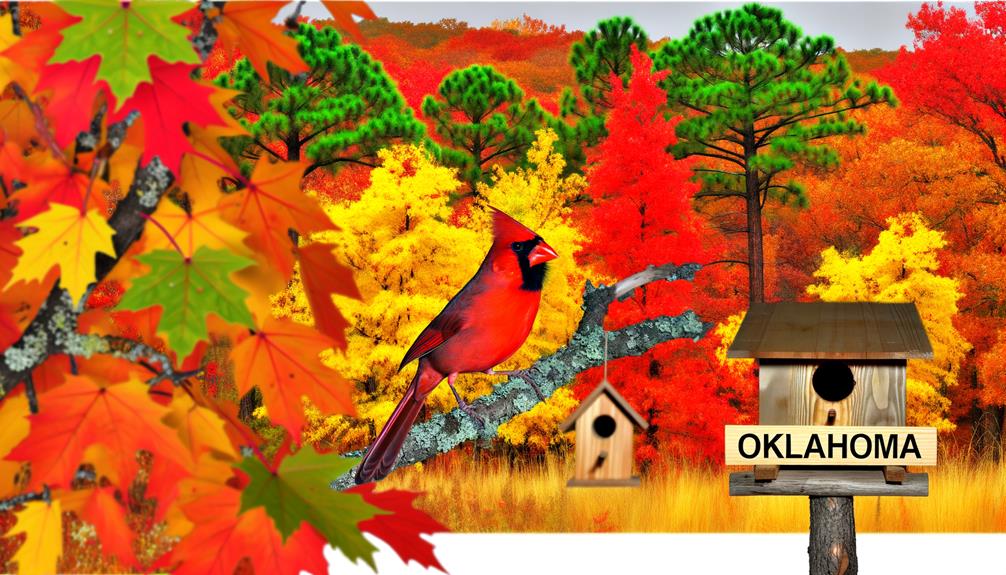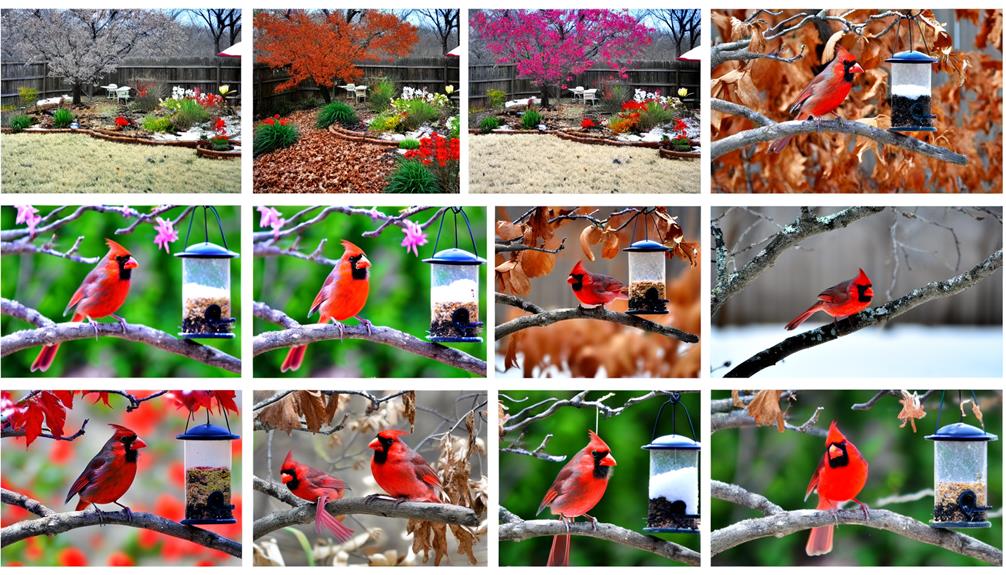Do Cardinal Birds Migrate in Oklahoma?
Cardinal birds don't migrate from Oklahoma; they stay year-round in their established habitats. These birds inhabit wooded areas, gardens, and shrublands, relying on abundant food sources like seeds, fruits, and insects.
During winter, cardinals adjust their foraging strategies to find up to 75% of their diet from seeds, frequenting bird feeders. Their adaptive behaviors, such as altering metabolic rates and thickening plumage, help them survive seasonal changes.
By observing their year-round presence and adaptability, you'll gain a deeper appreciation for these resilient birds. For more insights into their fascinating seasonal adaptations, there's plenty more to discover.

Key Takeaways
- Cardinal birds are non-migratory and remain in their chosen habitats year-round.
- Cardinals establish territories with dense foliage and open spaces for seasonal activities.
- In winter, cardinals rely heavily on bird feeders for seeds, sustaining their caloric needs.
- Adaptations like thickened plumage and altered foraging help cardinals survive cold temperatures.
- Cardinals' stable populations make them observable in Oklahoma throughout all seasons.
Cardinal Bird Habitats

Cardinal birds typically inhabit wooded areas, gardens, and shrublands, where they find ample food sources and shelter. You'll notice that these habitats provide an abundance of seeds, fruits, and insects, which are essential for the cardinals' diet.
Scientific studies indicate that cardinals prefer dense cover to protect themselves from predators and harsh weather conditions. The data shows that these birds are non-migratory, meaning they stay within their chosen habitats year-round.
Observational data reveals that they often establish territories in regions with a mix of dense foliage and open spaces, facilitating both nesting and foraging activities. By understanding their habitat preferences, you can appreciate how cardinals thrive in environments that offer both freedom and security, ensuring their survival and reproductive success.
Seasonal Behavior Patterns
Throughout the year, you'll observe that cardinal birds exhibit distinct seasonal behavior patterns, influenced by changes in temperature, daylight, and food availability. During spring, cardinals engage in territorial singing and nesting behaviors. Summer sees increased foraging and nurturing of fledglings. In fall, cardinals molt, replacing old feathers with new ones, and they begin to form winter flocks.
| Season | Key Behavior |
|---|---|
| Spring | Territorial singing, nesting |
| Summer | Foraging, nurturing fledglings |
| Fall | Molting, flock formation |
These patterns are essential for their survival and reproduction. Data shows that cardinals adapt their behaviors to seasonal shifts, ensuring they thrive regardless of the changing environment. By understanding these behaviors, you can better appreciate their resilience and adaptability.
Food Sources in Winter

As winter approaches, you'll notice that the availability of natural food sources such as insects and berries dwindles, leading cardinals to adjust their foraging strategies. Cardinals rely on seeds from plants like wild grasses and sunflowers. Data show that up to 75% of their winter diet consists of seeds.
You'll also observe them frequenting bird feeders more often, seeking out sunflower seeds and safflower. Studies indicate that feeders can sustain up to 80% of a cardinal's daily caloric needs during harsh weather.
To secure their survival, cardinals also exploit any remaining fruits, such as crabapples and dogwood berries. Your keen observation will reveal a remarkable adaptability, allowing cardinals to thrive despite the winter's scarcity.
Adaptation to Climate
Adaptability is essential for cardinals to cope with the varying climates they encounter during migration. They possess a remarkable ability to adjust their physiology, such as altering their metabolic rates to conserve energy in colder temperatures. You'll notice that their plumage thickens, providing better insulation.
Additionally, cardinals can change their foraging behavior to exploit available food sources, ensuring they meet their nutritional needs despite the climate. Studies show that cardinals have a higher survival rate in temperate regions due to these adaptive strategies.
Their resilience allows them to thrive in diverse environments, from Oklahoma's chilly winters to warmer locales. By understanding these adaptations, you can appreciate how cardinals maintain their freedom and endure the challenges of migration.
Observing Cardinals Year-Round

Cardinals' remarkable adaptability not only aids in their migration but also makes them fascinating subjects for year-round observation. In Oklahoma, you can observe these vibrant red birds throughout the changing seasons.
Data indicates that cardinal populations remain stable due to their ability to thrive in both urban and rural environments. You'll notice that cardinals prefer dense shrubbery and wooded areas, providing excellent cover and nesting sites.
Conclusion
You've now seen that cardinal birds don't migrate from Oklahoma; they adapt to the changing seasons. With winter food sources like seeds and berries, they're well-equipped to brave the cold. Their habitats remain consistent, and you can observe their vibrant plumage year-round.
Think of them as nature's steadfast sentinels, standing guard no matter the season. So, grab your binoculars and enjoy the red splash of cardinals against the winter snow—nature's data points in action.






